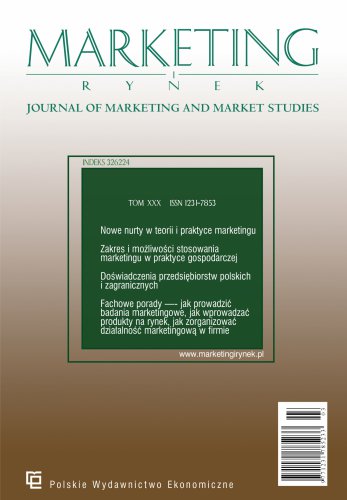The source of innovation: How the technology and innovation centre accelerates regional innovation capacity?
Fostering technology and innovation centres (TIC) is expanding globally; as a result, the concept of the capacity to be the source of innovation (CSI) is getting widespread attention. Four categories of CSI exist: CSI in knowledge, technology, industry, and system. The future development direction of China's TIC is examined by summarizing and contrasting the similarities and differences between three international TICs (Shanghai, Beijing, and Guangdong) and three regional TICs (Zhejiang, Hubei, and Liaoning) in China, in terms of policy texts, development positioning, and regional planning. All of that is done in order to investigate the relationship between the building of TIC and CSI. Additionally, based on the four different types of CSI, the corresponding improvement solutions are given.
References
References/Bibliografia
Akinfeeva, E. V., & Abramov, V. I. (2015). The role of science cities in the development of the national innovation system in Russia. Studies on Russian Economic Development, 26, 91–99. https://doi.org/10.1134/S1075700715010025
Berger, A., & Brem, A. (2017). Why do European companies have innovation hubs in Silicon Valley – Best practice examples and key takeaways. Thunderbird International Business Review, 59(6), 757–763. https://doi.org/10.1002/tie.21884
Binz, C., & Truffer, B. (2017). Global Innovation Systems – A conceptual framework for innovation dynamics in transnational contexts. Research Policy, 46(7), 1284–1298. https://doi.org/10.1016/j.respol.2017.05.012
Bozdogan, K., Deyst, J., Hoult, D., & Lucas, M. (1998). Architectural innovation in product development through early supplier integration. R&D Management, 28(3), 163–173. https://doi.org/10.1111/1467-9310.00093
Bruneel, J., d'Este, P., & Salter, A. (2010). Investigating the factors that diminish the barriers to university–industry collaboration. Research Policy, 39(7), 858–868. https://doi.org/10.1016/j.respol.2010.03.006
Clark, G. L., Feldman, M. P., Gertler, M. S., & Williams, K. (Eds.). (2003). The Oxford handbook of economic geography. Oxford University Press.
Cooke, P. (1992). Regional innovation systems: Competitive regulation in the new Europe. Geoforum, 23(3), 365–382. https://doi.org/10.1016/0016-7185(92)90048-9
Fagerberg, J., & Srholec, M. (2008). National innovation systems, capabilities and economic development. Research Policy, 37(9), 1417–1435. https://doi.org/10.1016/j.respol.2008.06.003
Filatotchev, I., Liu, X., Lu, J., & Wright, M. (2011). Knowledge spillovers through human mobility across national borders: Evidence from Zhongguancun Science Park in China. Research Policy, 40(3), 453–462. https://doi.org/10.1016/j.respol.2011.01.003
Franceschinis, C., Thiene, M., Scarpa, R., Rose, J., Moretto, M., & Cavalli, R. (2017). Adoption of renewable heating systems: An empirical test of the diffusion of innovation theory. Energy, 125, 313–326. https://doi.org/10.1016/j.energy.2017.02.060
Furman, J. L., Porter, M. E., & Stern, S. (2002). The determinants of national innovative capacity. Research Policy, 31(6), 899–933. https://doi.org/10.1016/S0048-7333(01)00152-4
Gerlach, S., & Brem, A. (2015). What determines a successful business incubator? Introduction to an incubator guide. International Journal of Entrepreneurial Venturing, 7(3), 286–307. https://doi.org/10.1504/IJEV.2015.071486
Hu, M. C., & Mathews, J. A. (2005). National innovative capacity in East Asia. Research Policy, 34(9), 1322–1349. https://doi.org/10.1016/j.respol.2005.04.009
Huergo, E. (2006). The role of technological management as a source of innovation: Evidence from Spanish manufacturing firms. Research Policy, 35(9), 1377–1388.
Jiménez, A., & Zheng, Y. (2018). Tech hubs, innovation and development. Information Technology for Development, 24(1), 95–118. https://doi.org/10.1080/02681102.2017.1335282
Kirner, E., Kinkel, S., & Jaeger, A. (2009). Innovation paths and the innovation performance of low-technology firms – An empirical analysis of German industry. Research Policy, 38(3), 447–458. https://doi.org/10.1016/j.respol.2008.10.011
Kline, S. J., & Rosenberg, N. (2009). An overview of innovation. In: N. Rosenberg (Ed.), Studies on science and the innovation process: Selected works by Nathan Rosenberg (173–203). World Scientific Publishing.
Paci, R., & Usai, S. (1999). Externalities, knowledge spillovers and the spatial distribution of innovation. GeoJournal, 49, 381–390.
Ritala, P., Olander, H., Michailova, S., & Husted, K. (2015). Knowledge sharing, knowledge leaking and relative innovation performance: An empirical study. Technovation, 35, 22–31. https://doi.org/10.1016/j.technovation.2014.07.011
Rosenberg, N. (Ed.). (2009). Studies on science and the innovation process: Selected works by Nathan Rosenberg. World Scientific Publishing.
Sohn, D. W., & Kenney, M. (2007). Universities, clusters, and innovation systems: The case of Seoul, Korea. World Development, 35(6), 991–1004. https://doi.org/10.1016/j.worlddev.2006.05.008
Su, T. (2019, February). Building Science and Technology Innovation Centre in Beijing should care about industry application. IOP Conference Series: Earth and Environmental Science, 237(5), 052063.
Szeto, E. (2000). Innovation capacity: Working towards a mechanism for improving innovation within an inter-organizational network. The TQM Magazine, 12(2), 149–158.
Troshin, A. S., Kupriyanov, S. V., Stryabkova, E. A., Saldanha, H. F. D., & Sandu, I. S. (2014). Role and place of economic mechanism in modern conditions. Life Science Journal, 11(10), 487–490.
Uzlov, K., & Li-chun, T. (2016). Indicator evaluation of regional innovation system according to the cluster approach. Scholedge International Journal of Business Policy & Governance, 3(12), 178–184. https://doi.org/10.19085/journal.sijbpg031201
Wu, J., Ge, Z., Han, S., Xing, L., Zhu, M., Zhang, J., & Liu, J. (2020). Impacts of agricultural industrial agglomeration on China's agricultural energy efficiency: A spatial econometrics analysis. Journal of Cleaner Production, 260, 121011. https://doi.org/10.1016/j.jclepro.2020.121011
Yam, R. C., Lo, W., Tang, E. P., & Lau, A. K. (2011). Analysis of sources of innovation, technological innovation capabilities, and performance: An empirical study of Hong Kong manufacturing industries. Research Policy, 40(3), 391–402. https://doi.org/10.1016/j.respol.2010.10.013
Yuasa, M. (1962). Centre of scientific activity: Its shift from the 16th to the 20th century. Japanese Studies in the History of Science, 1(1), 57–75.
Zhang, J. (2019, December). A study on innovation radiation effects of Shanghai Science and Technology Innovation Centre from the perspective of field theory. IOP Conference Series: Materials Science and Engineering, 677(4), 042044.
Zhao, S. L., Song, W., Zhu, D. Y., Peng, X. B., & Cai, W. (2013). Evaluating China's regional collaboration innovation capability from the innovation actors perspective – An AHP and cluster analytical approach. Technology in Society, 35(3), 182–190. https://doi.org/10.1016/j.techsoc.2013.06.001

